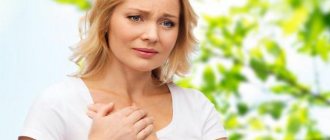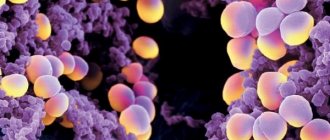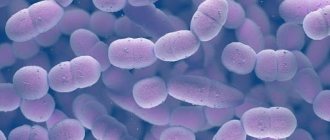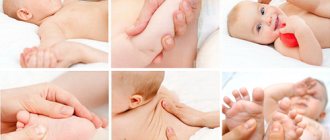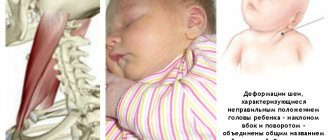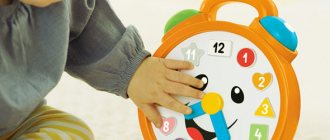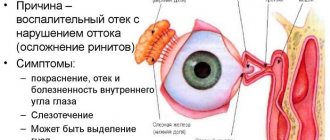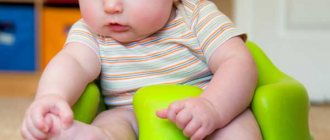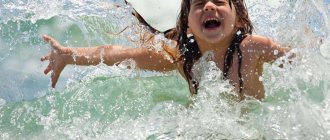Indications: when massage is needed
To understand when a child needs a massage when coughing, it is important to understand the manifestations of the disease:
- In the initial phase, while the inflammatory process is developing, the mucous membrane covering the bronchi is irritated and dry. A dry cough occurs, which is called non-productive. At this time, it is too early to do massage practices; there will be no benefit from them.
- On days 3-5, the cough becomes wet and productive: liquid discharge appears in the form of sputum. It's time to start a course of procedures.
- After the completion of the active phase of the disease and the cessation of coughing, it is recommended to continue the course of procedures for several more days.
It is necessary to understand that massage for coughs in children is always prescribed as additional therapy. This does not replace drug and physiotherapeutic treatment prescribed by a doctor.
Pediatricians recommend starting a course of cough treatments, in the absence of contraindications, as soon as the acute phase of the disease ends and the body temperature returns to normal (our review about suppositories for fever for children). Here are the main indications:
- complications after acute respiratory infections, flu;
- bronchitis, including COPD;
- some cases of pneumonia;
- pneumosclerosis;
- cystic fibrosis;
- remission during bronchial asthma.
The effect of drainage massage on the respiratory tract
Constipation in a one-month-old baby - what to do at home
During the process of drainage massage to expel sputum when a child coughs, the bronchial tree is heated, so the accumulated mucus becomes warmer and more liquid. It clears the throat better, is easily removed from the small bronchi into larger ones, and then into the trachea. This process helps to quickly get rid of mucus, viruses and germs.
Evgeniy Komarovsky, a pediatrician, urges you to initially resort to this procedure, and not try to immediately resort to drug treatment. As a bonus, he highlights the fact that the manipulation can be carried out starting from three months of the baby’s life, and it is not necessary to seek help from specialists.
In addition to stimulating mucus discharge, massage is useful because:
- lymph flow and blood flow are stimulated;
- muscle fibers that are involved in breathing are strengthened;
- the ribs become more mobile;
- respiratory function stabilizes;
- If the baby is already taking medications, their effect is enhanced.
Benefit: therapeutic effect of the procedure
The correct cough massage technique for children can significantly alleviate the condition during illness.
What happens as a result of well-performed manipulations:
- Bronchial mucus thins out and becomes more transportable.
- The movement and evacuation of sputum from the bronchi accelerates.
- Along with mucus, pathogenic microflora is removed from the body: bacteria, viruses, microorganisms.
- The mobility of the ribs increases, breathing and blood circulation in the chest are normalized.
- The effect of medications increases.
How does massage help remove mucus? With poor development of the respiratory muscles, coughing up sputum in children is difficult. Constant coughing irritates the throat, and coughing up phlegm becomes very painful.
As a result of massage manipulations, special cilia on the surface of the bronchial mucosa, designed to push mucus out, increase their activity. Stimulating blood circulation increases the production of bronchial secretions, which further thins the mucus.
Why do you need massage for coughs and bronchitis?
Bronchitis is an inflammatory disease of the respiratory system, which in most cases is caused by an infection (viral or bacterial).
The chronic form of the disease develops as a complication of acute bronchitis or as a result of the action of non-infectious irritants. In some cases, due to swelling of the mucous membrane, blockage of the bronchi develops. This type of bronchitis is called obstructive.
Massage counteracts the processes that occur during illness and is a condition for a speedy recovery. Namely:
- increases blood circulation;
- improves muscle contraction of the bronchial walls;
- promotes the tone and movement of the bronchial epithelium;
- activates breathing, normalizes oxygen exchange.
Rubbing the chest frees the respiratory system from phlegm, which causes intoxication. Massage for bronchitis helps to clear the throat.
The procedure is prescribed for adults and children, starting from infancy. For adults it is carried out more intensively.
Basic techniques
Classic techniques are designed for individual use or combination depending on the indication. General conditions to be observed:
- At least two hours should pass after eating.
- 30 minutes before the session, the child needs to take medications to thin the sputum.
- There should be no drafts in the room during the procedure; the air temperature should preferably be within 22-24 °C.
- After the session you cannot eat for about 1 hour.
Back massage
When coughing, the greatest effect is produced by manipulations in the upper and middle back. General principles:
- The patient's body is positioned so that the head is lower than the torso. This way, mucus can move freely through the respiratory tract.
- All movements of the massage therapist’s hands are directed from the lower back to the neck, that is, they create a “wave” of mucus movement towards the exit.
- At the end of the session you need to induce a cough.
- After the manipulations, it is advisable to cover the patient warmly.
Chest massage
The chest is massaged using circular, light movements.
After the procedure, it is recommended to apply a warm compress, for example, a honey cake. Additionally, massage the child’s chest in the front part. The patient is placed on his back. The upper part of the child's body is treated with circular rubbing, avoiding the area of the nipples, armpits and neck. The movements are directed upward, towards the neck. After massage practice, it is advisable to apply a warm compress to the chest area.
How to do exercises for babies
Carry out the procedures 40 minutes before feeding the baby or 1.5 hours after it. The specialist's hands must be warm. It is advisable to create a pleasant atmosphere so that the child does not cry, otherwise the procedure will have to be interrupted. Sequencing:
- The child is placed with his tummy on a soft pillow.
- Using gentle finger movements, they stroke and lightly rub your back.
- When the skin turns pink, the baby is warmly wrapped and laid down.
By studying available and popular methods using videos and familiarizing yourself with different techniques, you can choose the optimal massage method for removing sputum in children. Once you learn how to do it yourself, you can successfully use these techniques when treating your children.
The body's goal is to get rid of phlegm, and the goal of treatment is to help it do this. I always recommend that mothers do drainage and honey massage for children over 3 years old when treating wet cough .
Once you learn how to do it, you can successfully use this skill for many years. Massage techniques not only help to cope with the disease faster, but also promotes the proper development of the child’s skeleton and muscles (on the issue of muscle hypotonia), improves posture, increases chest mobility, and increases immunity. The benefits of such procedures can hardly be overestimated.
Recommendations and Cautions
Despite the fact that massage is considered a safe procedure, it is best performed for medical reasons after a comprehensive diagnosis. Any self-medication for respiratory diseases can lead to worsening of the condition and serious complications. In addition, it is important to take into account the existing contraindications, and in the presence of chronic diseases, the possible harm that too intense exposure can cause to the body.
Adult patients can perform massage on their own if they are feeling well. For children, especially infants, therapeutic and preventive procedures should be carried out exclusively by a specialist. In addition, we must not forget that massage is only part of a comprehensive treatment and cannot replace drug therapy.
Types of massage
| Child's age | Types and features of manipulations | Duration of procedures |
| Up to 3 months | Babies at this age are not prescribed massage | – |
| 3 months-1 year | Only a professional massage therapist can perform therapeutic procedures. The session consists of light stroking, rubbing and finger tapping. Be sure to use neutral oil for your baby's skin. | Up to 5 minutes, 1 time per day |
| 1-3 years | You can perform light vibration massage with caution, as well as honey massage - in the absence of an allergic reaction | 5 to 10 minutes, up to 2 times a day |
| 3-7 years | It is allowed to use percussion, drainage and honey techniques (without oil), and cupping techniques - with the use of neutral oils | 15-20 minutes, up to 3 times a day |
| Over 7 years old | All types of massage manipulations are allowed | 25 minutes, up to 4 times a day |
Drainage
When performing drainage massage for children when coughing, make sure that the middle part of the patient’s torso is higher than the head . The patient lies face down with a pillow placed under the stomach. Main stages of action:
- Warming up the chest. It is performed by stroking and rubbing movements.
- Warm up the intercostal muscles. Light longitudinal movements are used to treat the back and sides from bottom to top. The spine area is not affected.
- Using pinching movements, the entire surface of the back is worked in the direction from the lower back to the head.
- The edge of the palm is used to tap the entire back from bottom to top.
- Using both hands, lightly compress the body from the sides in the diaphragm area.
The video below additionally explains in what cases drainage massage is prescribed and the correct technique for performing it:
Vibrating (percussive)
An example of performing vibration chest massage for children is presented in the video. This simple method consists of repeatedly tapping the back with the edge of the palm in the direction from the middle of the back to the neck.
The implementation option that Dr. Komarovsky shows is tapping the fingers of a weakly clenched fist. The spine area is not treated. After the session, you need to invite the patient to cough well, moving him to an upright position.
Percussion massage for children is the easiest and fastest method for getting rid of excess mucus accumulation in the respiratory tract.
Honey
Having found out whether the child is allergic to bee products, you can conduct a session of therapeutic manipulations with honey. This qualitatively warms up the chest and increases blood circulation. Sequencing:
- Body position – lying on your stomach.
- The back is warmed up with light rubbing and stroking movements.
- Apply a sufficient amount of liquid honey and distribute it evenly.
- The stroking movements end with a sharp lifting of the hands from the skin, while the sticky honey creates difficulty.
- The procedure is completed by wiping off the remaining honey and wrapping it warmly.
Spot
This popular method, developed in China, requires special knowledge and skills. Acupressure for coughs in children can only be effectively performed by a qualified specialist . The technique uses biologically active points located on the energy meridians of the body organs. Not only the correct choice of location is important, but also the strength and duration of the impact on the meridians.
Canning
This method increases subcutaneous blood circulation in the chest and strengthens the overall immunity of the body. Medical jars made of glass or rubber are used for it. Stages of the treatment session:
- Abundantly lubricate the skin with oil or cream.
- Installation of cans.
- Sliding movements with cups, capturing part of the skin inside the jar.
- The entire surface of the back is worked, excluding the areas of the spine and armpits.
- The session ends with a warm wrap.
How to prepare for the cupping massage procedure and the technique for performing it, watch the video:
Contraindications: in what cases the procedure cannot be performed
There are a number of restrictions for performing procedures in children. In addition to the acute phase of a respiratory or infectious disease, which is always a contraindication, there are the following risk factors:
- Heart diseases, including congenital defects.
- Diseases of the kidneys and liver in the acute phase.
- Allergic manifestations on the skin (see more about the types of rashes in a child).
- Asthma during an attack.
- Oncological diseases.
- Nervous system disorders.
- Body weight deficiency.
- Hernias.
About the TOP 12 antiviral drugs for children from 1 year old are written in this publication, and about the treatment of barking cough in this article.
From parents' reviews
Yulia, 33 years old, Podolsk, son 5 years old
During my son’s treatment for bronchoneumonia, I learned from my local doctor about the opportunity to undergo a course of special drainage massage at the clinic. After 10 sessions, the son began to sleep better, and the night coughing attacks gradually disappeared.
Of course, this was done at the very end of treatment, after a course of antibiotics and inhalations. But my baby liked the procedure, and now we often do it at home. The son himself comes up and asks to massage him!
